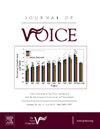Classification of Voice Quality Using Neck-Surface Acceleration: Comparison With Glottal Flow and Radiated Sound
IF 2.5
4区 医学
Q1 AUDIOLOGY & SPEECH-LANGUAGE PATHOLOGY
引用次数: 0
Abstract
Objectives
The aim of the present study is to investigate the usefulness of features extracted from miniature accelerometers attached to speaker’s tracheal wall below the glottis for classification of phonation type. The performance of the accelerometer features is evaluated relative to features obtained from inverse filtered and radiated sound. While the former is a good proxy for the voice source, obtaining robust voice source features from the latter is considered difficult since it also contains information about the vocal tract filter. By contrast, the accelerometer signal is largely unaffected by the vocal tract and although it is shaped by subglottal resonances and the transfer properties of the neck tissue, these properties remain constant within a speaker. For this reason, we expect it to provide a better approximation of the voice source than the raw audio. We also investigate which aspects of the voice source are derivable from the accelerometer and microphone signals.
Methods
Five trained singers (two females and three males) were recorded producing the syllable [pæ:] in three voice qualities (neutral, breathy and pressed) and at three pitch levels as determined by the participants’ personal preference. Features extracted from the three signals were used for classification of phonation type using a random forest classifier. In addition, accelerometer and microphone features with highest correlation with the voice source features were identified.
Results
The three signals showed comparable classification error rates, with considerable differences across speakers both with respect to the overall performance and the importance of individual features. The speaker-specific differences notwithstanding, variation of phonation type had consistent effects on the voice source, accelerometer and audio signals. With regard to the voice source, AQ, NAQ, and CQ all showed a monotonic variation along the breathy – neutral – pressed continuum. Several features were also found to vary systematically in the accelerometer and audio signals: HRF, and CPPS (both the accelerometer and the audio), as well as the sound level (for the audio). The random forest analysis revealed that all of these features were also among the most important for the classification of voice quality.
Conclusion
Both the accelerometer and the audio signals were found to discriminate between phonation types with an accuracy approaching that of the voice source. Thus, the accelerometer signal, which is largely uncontaminated by vocal tract resonances, offered no advantage over the signal collected with a normal microphone.
利用颈面加速度对声音质量进行分类:与喉流和辐射声的比较
研究目的本研究旨在调查从声门下方说话者气管壁上的微型加速度计中提取的特征对发音类型分类的有用性。相对于从反滤波和辐射声音中提取的特征,本研究对加速度计特征的性能进行了评估。虽然前者可以很好地代表声源,但从后者获得可靠的声源特征却很困难,因为它还包含声道滤波器的信息。相比之下,加速度计信号在很大程度上不受声道的影响,虽然它会受到声门下共振和颈部组织传递特性的影响,但这些特性在说话者体内保持不变。因此,我们希望它能提供比原始音频更好的声源近似值。我们还研究了声源的哪些方面可以从加速度计和麦克风信号中推导出来:我们录制了五名训练有素的歌手(两名女性和三名男性)以三种音质(中性、喘息和压抑)和三种音高水平发出音节 [pæ:],音高水平由参与者的个人偏好决定。从这三种信号中提取的特征用于使用随机森林分类器对发音类型进行分类。此外,还确定了与声源特征相关性最高的加速度计和麦克风特征:结果:三种信号的分类错误率相当,但不同说话者的整体表现和单个特征的重要性存在很大差异。尽管说话者之间存在差异,但发音类型的变化对声源、加速度计和音频信号的影响是一致的。在声源方面,AQ、NAQ、L1L2 和 CQ 都沿着喘息--中性--按压的连续统一体显示出单调的变化。在加速度计和音频信号中也发现了一些系统性变化的特征:HRF、L1L2 和 CPPS(加速度计和音频)以及声级(音频)。随机森林分析表明,所有这些特征也是语音质量分类中最重要的特征之一:结论:研究发现,加速度计信号和音频信号都能区分发音类型,其准确度接近声源的准确度。因此,与使用普通麦克风采集的信号相比,基本不受声带共振污染的加速度计信号没有优势。
本文章由计算机程序翻译,如有差异,请以英文原文为准。
求助全文
约1分钟内获得全文
求助全文
来源期刊

Journal of Voice
医学-耳鼻喉科学
CiteScore
4.00
自引率
13.60%
发文量
395
审稿时长
59 days
期刊介绍:
The Journal of Voice is widely regarded as the world''s premiere journal for voice medicine and research. This peer-reviewed publication is listed in Index Medicus and is indexed by the Institute for Scientific Information. The journal contains articles written by experts throughout the world on all topics in voice sciences, voice medicine and surgery, and speech-language pathologists'' management of voice-related problems. The journal includes clinical articles, clinical research, and laboratory research. Members of the Foundation receive the journal as a benefit of membership.
 求助内容:
求助内容: 应助结果提醒方式:
应助结果提醒方式:


